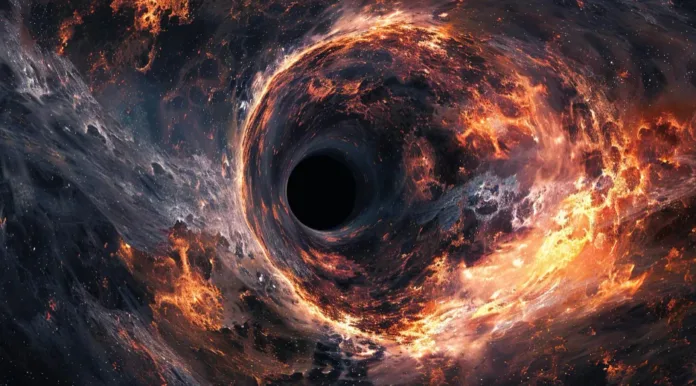A colossal flare from a distant supermassive black hole is the brightest ever recorded, shedding new light on cosmic events
In an extraordinary discovery that’s shaking the foundations of astrophysics, scientists have captured the most powerful flare ever recorded from a supermassive black hole, located 10 billion light-years away in the distant universe. This rare and unprecedented event, observed by the Zwicky Transient Facility (ZTF) and the Catalina Real-Time Transient Survey, reveals an accreting black hole that exploded with 30 times the brightness of any previous flare, shining with the power of 10 trillion suns.
The event occurred at a supermassive black hole called J2245+3743, which resides in the heart of a distant active galactic nucleus (AGN). This AGN is a type of black hole known for rapidly pulling in surrounding gas and matter, which generates immense amounts of energy. However, what sets J2245+3743 apart is the sheer intensity of its flare, which brightened by a factor of 40 over several months.
Matthew Graham, a research professor of astronomy at Caltech and the lead author of the study, expressed the enormity of the discovery: “The energetics show this object is very far away and very bright. This is unlike any AGN we’ve ever seen,” he said. The flare was so powerful that it was visible from Earth, even though it took billions of years for the light to reach us. The immense scale of the event has left researchers astonished, providing a new and exciting chapter in the study of black holes.
The research team believes that the cause of this flare is a tidal disruption event (TDE), a rare phenomenon where a supermassive black hole’s immense gravitational pull tears apart a star that ventures too close. This process results in the star being shredded and slowly consumed by the black hole. In this particular instance, the researchers estimate that the black hole devoured a star at least 30 times the mass of our Sun—far larger than typical stars that undergo such violent fates.
Embed from Getty Images
The flare’s discovery has provided a unique opportunity to study the powerful forces at play in the universe. Astronomers have long known that supernovae can release enormous amounts of energy, but the sheer scale of this black hole flare dwarfs any supernova observed so far. According to co-author K. E. Saavik Ford, professor at CUNY Graduate Centre and AMNH, “If you convert our entire Sun to energy using Einstein’s famous equation E=mc², that’s how much energy has been pouring out from this flare since we began observing it.”
The researchers initially found the object in 2018, and at first, there were no signs that it was extraordinary. It wasn’t until 2023 that they noticed the flare was lasting much longer than expected, prompting them to investigate further. Using multiple observatories, including the W. M. Keck Observatory in Hawai’i, they confirmed that this flare was indeed the brightest ever recorded from a supermassive black hole.
The black hole in question, which is 500 million times the mass of our Sun, resides in an AGN, a type of black hole that typically houses a swirling disk of gas and dust that fuels its feeding frenzy. These AGNs are commonly found in the centres of galaxies, but the flare from J2245+3743 is the largest one ever recorded from such a source.
The researchers are optimistic that this discovery will lead to further breakthroughs, particularly in identifying other unusually large TDEs across the universe. The team plans to sift through more ZTF data to uncover additional events of this magnitude. As Graham points out, “We’ve been observing the sky with ZTF for seven years now, so when we see anything flare or change, we can see what it has done in the past and how it will evolve.”
In the grand scheme of things, the discovery of such a powerful black hole flare not only pushes the boundaries of what we know about these enigmatic cosmic giants but also opens up a new avenue for investigating the most energetic phenomena in the universe. The team is hopeful that more observations will lead to greater insights into the fundamental processes of the cosmos.
